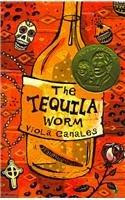The second book I read this summer was about Sophia (didn't seem to have a last name??), the
bright child of Mexican immigrants living in a bordertown in the southwest. “The Tequila Worm” by Viola Canales has been
on my list for quite some time, as it is both an award-winner (Pura Belpre) and
another new voice in the growing field of Hispanic literature for teens. Unfortunately, I struggled with this book in
an almost identical way as I did with the Jack Gantos book, “Dead End in
Norvelt.” Both stories are essentially
memoirs that have been fictionalized.
I’m not a fan of the style. I
kind of think that if you are going to write a memoir, you write a memoir. Trying to make a personal story into a
fiction novel leads to many issues which don’t make for strong writing. First and foremost, both Norvelt and this
book have very weak storylines. There is
a general theme of “growing up” but meaning is gathered – and sometimes
stretched – from one disconnected event to another. The tale begins when Sophia is six (?) and
visited by the neighborhood storyteller.
Using a variety of props, she tells Sophia who she is and presents a
tequila worm … the significance of which I never fully figured out (despite its
presence throughout). The book careens
through other moments in Sophia’s life, highlighting struggles that help define
her character. This is another problem
with these books. Because the focus is
on “their life” the main character is often defined by others. The characters around Sophia are clear, but I
couldn’t always see her, only how others reacted to her. It’s as if the author is so much in her own
head that she forgets the reader needs to have the main character as fully
developed as the colorful people who drop in along the way. My additional beefs are minor, but indicative of the
kind of odd focus of these kinds of books.
Bad things are sometimes “smoothed over” and arguments disappear
quickly. Sophia and her mom have a
disagreement near the end of the book which is resolved in a single
paragraph. (Tell me the last time that
ever happened between a mother and daughter!)
There is an over-emphasis on food, with nearly every snack described in
detail. This might be representative of
the culture, but it did make me wonder if Mexican-Americans suffer from
diabetes much. My one take-away was the
“Canicula” – a Mexican-American version of dog days which explains everything
going wrong in the dead of summer. I
have thought of it often in these last few weeks (did I mention a massive tree
branch crashed down outside my window today???)
I continue to seek out Hispanic literature for my students, and this
book, with its specific Mexican-American focus (it also helps to know a little
something about Catholicism), may not suffice. I’ve noticed that these stories tend to focus
on the Hispanic experience of the Southwest.
People of California and Texas may relate to the
tales of Francisco Jimenez, Benjamin Saenz and Canales, but those of us on the
east coast need something different.
Most of our kids hail from El Salvador,
Colombia, and other nations
in central and South America and they tend to
connect with stories that stress urban settings over intact cultural family
institutions that you might find along the border. I think that the works of Judith Ortiz Cofer and E.R.
Frank, for example, are more likely to appeal to my immigrant students than this story. Sorry, this award-winner wasn’t for me.
After many years of running this bookblog my life has shifted a bit. I will continue to review books I am reading but will be adding in TV and movie reviews as well. Enjoy! Check out my companion blog: http://dcvegeats.blogspot.com/
Friday, September 07, 2012
“The Red Blazer Girls: The Ring of Rocamadour” by Michael D. Beil
Well, I didn’t read as much as I would have liked this
summer. Oddly, two of the books I did
read had main characters with very similar names. The first was Sophie St. Pierre in Michael
Beil’s “The Ring of Rocamadour.” A newer
series, it hasn’t been discovered yet by my students, and that is a shame. Heralding back to teen mystery series of the
past, it’s like a contemporary Nancy Drew with superior writing and
characterizations. Fans of “The Westing
Game” will finally be able to find solace in an equally strong story that moves
quickly and has nice little puzzles to solve.
Older students may not be interested in the book because Sophie is only
a 7th grader, but she is a New Yorker, and feels a tad more
sophisticated than your average 12 or 13 year-old. It is the Sophie character that makes the
story so engaging to me. Unlike Nancy
Drew, Sophie is not the smartest, most bold or most suave of her friends. She is appealingly flawed, and owns up to her
mistakes as well as her successes. It is
her narrative voice, which speaks directly to the reader, that brings a real
element of fun to this tale. At one
point in the book, she insists that the reader stop and solve the puzzle –
rather forcefully! Each of the short
chapters is titled with an amusing self-effacing reflection by Sophie. Despite the overwhelming odds/girl detective
thing, the characters come off as real and I had to check the author’s bio
several times to remind me that he was, in fact, a male. No doubt he is able to draw from his
students’ experiences in creating this series.
Authentic, accessible and well-wrought.
Bravo, Mr. Beil. I look forward to
reading the next one.
Subscribe to:
Posts (Atom)

